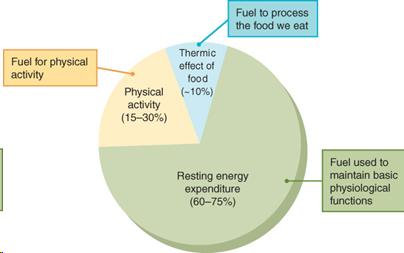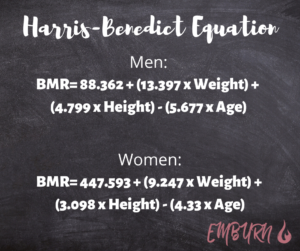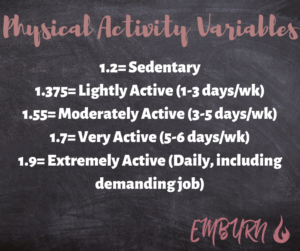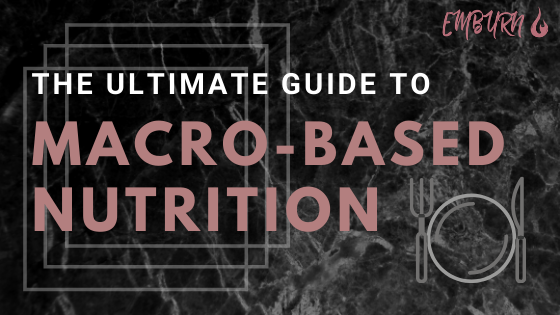What is Macro-Based Nutrition?
In this guide we will be discussing Macro-Based nutrition. Macro-based nutrition is following a daily food intake based off of macro-nutrient percentages that fit your body and your goals.
There are a lot of variables that go into finding what your body’s needs are in terms of macro-nutrients. In this blog, we will be going through each variable and discussing how to calculate your needs. We will also look at your personal goals and how they will impact your nutritional needs.
Energy Balance
When it comes to any weight-related goal, we first need to look at energy balance and what it means. The weight displaced on your scale is a product of energy balance. It’s a product of the energy you take in verses the energy you put out. Your energy input refers to your diet, your energy output refers to your daily calories burned. We will get more in-depth with input vs. output in a later part of this blog, but first we need to start with the basics.
When a person is gaining weight, they have a positive energy balance. What this means is they are taking in more than they are burning. The body stores the surplus of calories as 2 different things; fat, as a long-term energy reserve, and glycogen, as a short-term carbohydrate reserve.
When a person is losing weight, they have a negative energy balance. This means they are eating less than they are burning throughout their day. In this scenario the body uses the glycogen and fat as fuel which takes from the surpluses and results in weight loss.
As you can see, it is all about balancing your input and output. No, certain foods do NOT make you fat…but eating more calories than you burn will. No, pasta is not the enemy, eating too many calories is.
Input
Input refers to the calories you are consuming. These calories can be split into 3 different macro-nutrients; Protein, Carbohydrates, and Fat (Lipids).
Protein
Protein is an important macro-nutrient that your body uses to build and repair tissue. It is the main building block for muscle, bone, cartilage, skin, and blood. Because protein support the product of muscle, and muscle is a very metabolic tissue, eating more protein can promote weight loss.
When consuming calories from protein, it is important to know that 1 gram of protein is equal to 4 calories. Ex: If 4.5oz of chicken breast has 39 grams of protein, 156 calories of that portion of chicken comes from protein (39×4).
Protein is the most satiating of the 3 macro-nutrients, so if you are trying to lose weight it is important to incorporate a decent amount of protein in each meal to stay full for longer.
Carbohydrates
Carbohydrates are often looked at as the “bad guy” in modern day diets. This however, is not true. As we discussed above: certain foods do not make you fat, over eating calories makes you gain weight. Carbohydrates do a lot for our body. They provide us with energy, store energy, build macro-molecules, and spare our other macro-nutrients by allowing them to do their jobs while carbs are used up for most energy sources. Carbohydrates are broken down into glucose in digestion, which is used as energy for most cells.
When consuming calories from carbohydrates, it is important to know that 1 gram of carbohydrate is equal to 4 calories.
Lipids (Fats)
The last macro-nutrient is fat. Dietary fats are essential to provide your body with energy and to support cell growth. They also help protect your organs and help keep you warm. Dietary fats help you absorb some key nutrients and produce hormones.
When consuming calories from fat, it is important to know that 1 gram of fat is equal to 9 calories. Ex: 1/4 Cups of almonds contains 14g of fat, which equals 126 calories from fat.
Fat is the least satiating of the 3 macro-nutrients, meaning it keeps you full for the least amount of time.
Output
Now that we know what our input is made up of, let’s look at output. Our bodies expend energy for 3 different reasons:
- Maintain Physiological Functions
- Power Exercises
- Process the Food we eat
The total calories from all 3 methods equal your calories burned per day, and is known as your Total Energy Expenditure or T.E.E.

Maintaining Physiological Functions
Your physiological functions are things that happen in your body involuntarily. This includes your heart beat, respiration, nervous functions, muscle tone, body temperature, etc. This is known as your Basal Energy Expenditure (B.E.E.) or Resting Energy Expenditure (R.E.E.)
Your B.E.E is measured as your Basal Metabolic Rate or B.M.R.
Your BMR makes up 60-75% of your T.E.E.
Components that effect your BMR include age, gender, body size, and muscle development. The biggest component that comes into play is your Lean Body Mass. We learned earlier that muscle is a metabolic tissue, so the more muscle you have, the more calories you burn at rest. Lean Body Mass explains 70-80% of variation in BMR among individuals.
Physical Activity
Calories burned from physical activity account for 15-30% of your T.E.E.
This could include anything from everyday activities to training. Every action you preform has a different energy expenditure. It takes more energy to move a bigger body, just like it takes more energy to give a harder intensity.
When we get into the equation section of this post we will look at which variable fits your lifestyle.
Thermic Effect of Food
When you eat, your body is burning calories. Your body uses energy to digest, absorb, and metabolize your food, which generates heat; this is known as the Thermic Effect of Food.
Your T.E.F makes up for 10% of your T.E.E. When it comes to macro-nutrients, fat has the lowest thermic effect and protein has the highest. This is because converting protein to energy stores requires more energy than storing excess dietary fat as body fat.
Estimating Your T.E.E.
Now that we know what variables go into your Total Energy Expenditure (T.E.E.) per day, lets take a look at how to estimate this number.
T.E.E= BMR+PA+TEF
We will be calculating TEE in 3 steps.
1.BMR
2.PA
3.TEF
Estimating BMR Using Harris-Benedict Equation
The Harris-Benedict equation takes into account your age, weight (in kg), gender, and height (in cm).
- Calculate Height in cm by multiplying your height in Inches by 2.54
- Calculate your Weight in kg by dividing your weight in Pounds by 2.2
- Pick the equation below that fits your gender

Ex. I am 5’4″, 134lbs, and 26 years old. After changing my weight to kg and height to cm, my BMR is estimated to be 1401 calories.
You should now have the BMR variable, which is the first part of the T.E.E. equation. Next we will find the PA variable.
Estimating Your Physical Activity
To estimate your calories burned from physical activity, we will need your BMR number and your PA variable from the chart below.
PA= BMR x PA variable

Ex. My BMR is estimated to be 1401 calories. I would say I am moderately active.
1401 x 1.55 = 2,171 calories
This amount is showing the sum of my BMR and calories burned from PA.
If I subtract my BMR from this amount I will see that my PA is around 770 calories.
Estimating Thermic Effect of Food
The last thing we need to do is estimate your TEF.
TEF is 10% of your TEE.
Take your number from the previous section (mine was 2,171) and multiply by .1
2,171 x .1 = 217
My TEF is 217 calories.
TEE= BMR + PA + TEF
Ex. TEE= 1401 + 770 + 217
TEE= 2,388 calories
How Many Calories Should I Eat?
Now that we have an estimate of how many calories we burn through the day, we need to decide what our goal is for our lifestyle. I’m going to preface this section by saying you should find a competent coach to aid you along with this process. Eating too little can cause harm to your body, and eating too much will put you at risk for other health issues long term.
How do I cut calories to lose weight?
For weight loss, it really depends on the individual, which is why you should hire a competent nutrition coach, but today we will look at a generic answer. According to the Mayo Clinic, “Because 3,500 calories equals about 1 pound (0.45 kilogram) of fat, it’s estimated that you need to burn about 3,500 calories to lose 1 pound. So, in general, if you cut about 500 to 1,000 calories a day from your typical diet, you’d lose about 1 to 2 pounds a week.”
What this means is that we would take my estimated T.E.E of 2,388 calories, subtract 500 calories, and get a daily intake amount of 1,888 calories. This would put me at an estimated 1 pound loss per week for weight. Because a lot of factors go into weight loss, this may not be 100% accurate, but it is a basic guideline to follow.
WHAT do I eat to lose weight?
We have our daily intake amount of 1,888 calories per day to lose 1 pound per week.
We cannot, however, simply eat 1,888 calories or fast food and expect to, #1 feel full all day, and #2 see the body composition changes we want to see (we may see muscle loss instead of fat loss depending on our choices). So now the question of WHAT do I eat comes up.
Macro-nutrient Ranges
The acceptable macro-nutrient distribution ranges (AMDR) are 45–65% of your daily calories from carbs, 20–35% from fats and 10–35% from protein. These are set by the Food and Nutrition Board.
Proper macro-nutrient distribution is important in order to give your body the fuel it needs to survive, but that distribution can vary from person to person. Depending on your specific goals, you will need a certain amount of energy coming from each macro-nutrient. Having a good macro distribution can help with feeling full and also picking better foods that nourish your body.
From the section above regarding intake, we know that 1g of fat is equal to 9 calories, 1g of protein is equal to 4 calories, and 1g of carb is equal to 4 calories. Let’s look at what our macro breakdown would look like for me to lose weight at a 500 calorie deficit.
Intake: 1,888 calories
Carb ratio: 45%, 1,888x.45= 849 calories, 849/4(cal from carb)= 212g
Protein ratio: 35%, 1,888x.35= 661 calories, 661/4(cal from protein)=165g
Fat ratio: 20%, 1,888x.2= 378 calories, 378/9(calories from fat)= 42g
Conclusion
If you have a specific goal in mind for yourself, I will, for the 100th time tell you to hire a competent coach to help get your there faster and to help you understand the process. Using the information above will give you the estimate of your T.E.E, help you choose a calorie intake goal, and let you know the recommended breakdown for macro nutrition distribution. For a more in depth look, send me an email with your questions: emburnfitness@gmail.com
